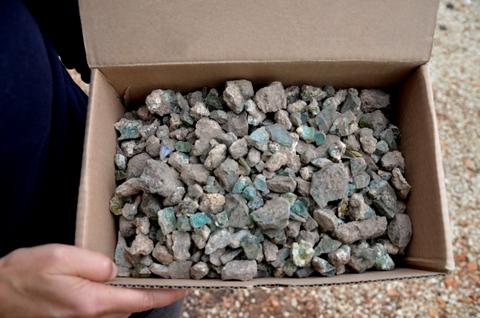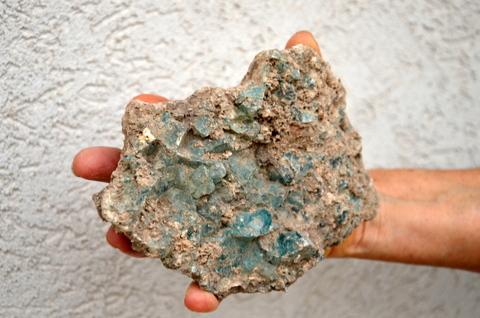Fragment found in large town that had developed glass industry, says Antiquities Authority: Who lived there is anybody's guess
Source - http://www.haaretz.com/archaeology/1.633334

The menorah imprints were probably made when the glass was still hot.
A fragment of a glass bracelet bearing motifs of the seven-branched candelabrum from the Second Temple was discovered during the Hanukkah holiday in work the Israel Antiquities Authority conducted near Eliakim, in the Mount Carmel National Park.
The IAA has been digging there to salvage antiquities prior to the construction of a water reservoir for the city of Yokneam. During the excavation an industrial region and refuse pits were exposed, belonging to a large settlement dating from the Late Roman and Early Byzantine periods (late 4th century CE to the start of the 5th century). In the refuse pit, the diggers found hundreds of glass fragments.

Glass fragments. Photo: Israel Antiquities Authority
Among them was the fragment from the bracelet, made of turquoise glass. After cleaning, it proved to bear two symbols of the 7-branched menorah, a symbol of the Temple on Jerusalem. One shows a plain seven-branched menorah, of which only the surface of the menorah is visible. The other shows a seven-branched menorah with flames above its branches.

The piece of bracelet with the menorah motifs. Photo: Israel Antiquities Authority
Given that the glass fragment is quite small, how can we know it came from a bracelet as opposed to some other item of apparel or decoration? "Its diameter. It could not possibly be anything else," Yael Gorin-Rosen, head of the Ancient Glass Department at the Israel Antiquities Authority, told Haaretz.
“It seems that the bracelet was embossed with the decoration while the glass was still hot," Limor Talmi and Dan Kirzner, the excavation directors on behalf of the Israel Antiquities Authority said in a statement.
Apparently the menorah motif was a thing back then. Gorin-Rosen says three bracelet fragments with menorah decorations have been found in Israel: at Bab el-Hawa in the northern Golan Heights, at Banias, also in the Golan, and a third discovered at Shikmona, Haifa. That last one also shows a menorah with flames, she says.
“Jewelry such as this was found in excavations, usually in the context of funerary offerings," Gorin-Rosen says. "It is unusual to find such objects in settlement strata, and even rarer to discover them in an ancient refuse pit.”
So does that prove the ancient town was peopled by Jews? No. It might have been, or might have been settled by Samaritans or pagans or, given the date of the town, early Christians. It might have been manufactured in the town for sale elsewhere, points out Gorin-Rosen: the archaeologists found clear remains of glass production activities, she says, including the congealed glass goo from the bottom of a glass kiln (see picture below). Also, the ancient trash from the town included a great deal of glass.

Glass 'slag' found at the bottom of a kiln. Photo: Israel Antiquities Authority
Among the ancient jewels found in Israel are the "buried Canaanite treasure" found in 2012 in Megiddo, from around 1100 BCE. Inside a clay vessel, archaeologists found another clay vessel – inside of which they found gold and silver jewelry and semiprecious stones from 3,100 years ago. In 2013, jewelry, coins and other treasures were found at a dig at Arsuf, and in May this year, a hoard of silver jewelry featuring mainly earrings was discovered from the Late Bronze Age, about th3 13th century BCE, at Abel Beth Maacah.